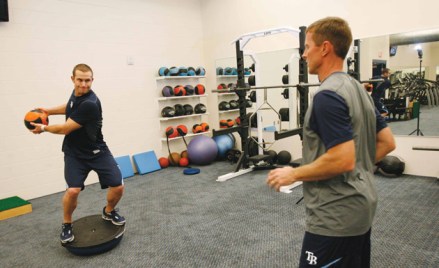What’s wrong with the picture above? Looks like a fun 9 or 10 year-old baseball game here in Phoenix, right?
Check out the dad behind the screen. Do I see that correctly? Is he really holding a radar gun?
I’m absolutely sickened by this image.
There are just so many things wrong here. Please pass this post on to everyone you know in the baseball community. I’ll attempt to break down just a few of the disasters here – and try not to rant too long.
The Radar Gun
First of all, with all of the things we now know about young pitchers and arm injuries, the last thing any young pitcher needs to be concerned with is radar gun velocity.
Dr. James Andrews is arguably the world’s most famous and best orthopedic surgeon, and he has saved the pitching arms of some of the greatest professional baseball players on the planet. To the right is an image of what actually takes place when doctors have to rebuild the joint and the ligament.
So when he has a request for the game he loves the most, we should be wise and listen to his request — especially at the youth and high school level.
“I think they should outlaw the radar gun,” he said. “Young pitchers, coaches, scouts and parents put so much emphasis now on throwing hard that these kids are hurting their elbows and their shoulders because they’re trying to throw 90 mph.”
The radar gun, Andrews says, is one of many injury risks at the youth and high school level in an age of baseball that is seeing more and more teenage athletes on the operating table instead of the pitching mound.
You should read more from Dr. Andrews here…
You should read more from Major League Baseball and PitchSmart here….
The Complete Lack of Perspective on Youth Baseball
What in the world is this dad thinking? How does measuring the velocity of a 9-year old pitcher have anything to do with what is  important in a 9-year old baseball game?
important in a 9-year old baseball game?
Baseball is one of the most difficult games ever invented – it’s a self-esteem destroyer on it’s own. We need to be encouraging our kids at the youth level, not measuring the exit velocity of the fastball, for crying out loud.
The goal at the end of every 9 year-old baseball game is that the kid wants to come back and do it again.
I’ve got to turn it over to Steve Springer here so you can see his video on what’s important….a must watch for all baseball parents. Like Spring says, take the kid out for ice cream after the ballgame. Tell him how much you love him and how much fun you had watching him.
Also, see Brian Regan’s comedic take on youth baseball that will give you some insight on how many kids view the game.
The Singular Lack of Perspective on Pitching
Youth pitching is completely about having fun and learning to handle yourself on the mound. And that, by the way, isn’t easy. It’s also about learning proper pitching mechanics and throwing strikes. Period.
There is absolutely no way that any kid’s baseball future can be determined by how hard he throws or how effective he is when he’s 9.
With that said, there’s absolutely no way you can determine a kid’s baseball future in any way when he is 9 years of age.
The Absolute Unawareness of His Position in the Stands
Dude. Assuming that your son is the pitcher, he really needs to be concentrating on the catcher’s glove.
Not you right behind home plate holding that radar gun. I bet you give him the thumbs up when he throws a good pitch, too.
You know and I know (and I’m sure his coaches do, too) that he’s looking at you half of the time – and that’s not at all how it should be.
Secondly, you are more than likely blocking the view of other parents, grandparents, other family members, and friends at that ball game. You are taking up prime viewing real estate to get the 51 MPH reading, man. I’m also sure they are really impressed that he’s breaking 50 MPH from 46 feet.
Well, that’s what I’ve got for now – I can’t take this much longer. Please, please parents, encourage your youngsters. They need someone there for them after they fail – and they will in this game. Again, I ask that you share this post with anyone you know in the baseball community – let’s make sure we are encouraging and protecting our young players and pitchers.























